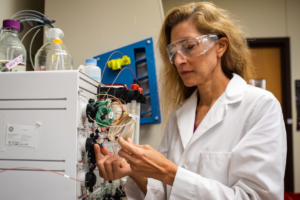Dr. Marilyn Armour is associate professor in the university’s School of Social Work.
Across the country, in increasing numbers, crime victims are asking for face-to-face meetings with offenders who have hurt them or their families.

This approach, called restorative justice, is grounded in the belief that those who are most directly affected by wrongdoing, usually the victim, offender and community, should have the opportunity to become actively involved in redressing the harm caused by that violence. Advocates of this philosophy contend that bringing together the key stakeholders in the aftermath of a wrongful act and establishing a safe climate for dialogue allows a more meaningful and healing response.
The Institute for Restorative Justice and Restorative Dialogue in the Center for Social Work Research is concerned about how we, as a society, respond to the harm that comes from wrongdoing and oppressive social forces. The institute aims to expand the focus from punishment of the offender to dealing more broadly and directly with the harm done by advancing victim healing, offender accountability and community safety through the use of restorative solutions. Aware of the unprecedented rise in violence, a drastic deterioration of community fabric and a growing sense of personal peril, this institute helps the community to develop options about responding to interpersonal harm that reinstate rather than diminish our humanity toward each other.
The effectiveness of restorative justice lies in its ability to provide communities with a new direction for its citizenry to be meaningfully invested in the social health and well-being of their neighborhoods. Indeed, doing restorative justice work has a sleeper effect. In the aftermath of crime and other wrongdoing, participating stakeholders discover that it has the power to renew and instill the kind of hope that can treat the toxicity of indifference that today’s cynicism breeds.
Restorative justice has been used in schools, with young people as a diversion from entering the criminal justice system and for young people returning to their communities after residential incarceration. It has also been used in response to dating and domestic violence, for hate crimes, student misconduct in higher education, senior abuse, adult crimes of severe violence and offender re-entry.
Although the hope generated by restorative justice is appealing, this approach challenges traditional thinking. The idea of bringing victim and offender together to repair the harm related to wrongdoing is an anathema to those who contend that vindication requires ever-increasing levels of punishment commensurate with the victim’s suffering.
Consequently, although restorative justice has demonstrated its effectiveness to heal, reduce recidivism and save taxpayer dollars, it is commonly met with muted curiosity and hesitancy to change current practices. It is important, therefore, to highlight the gift in restorative justice, namely the opportunity to advance healing for all concerned. In restorative justice, healing is an interactional process that seeks to mend the brokenness in social relationships created by wrongdoing while empowering the stakeholders to move forward. As such, healing is liberating because it can re-establish a sense of wholeness for the victim, offender and community that transcends the suffering otherwise associated with the wrongdoing.
The Institute for Restorative Justice and Restorative Dialogue, along with the School of Social Work, Division of Diversity and Community Engagement and numerous community agencies will co-sponsor the Fifth Annual Liberation-Based Healing Conference to be held in Austin Nov. 5-6 at El Buen Samaritano. The conference is open to the community and offers a rare opportunity for dialogue and inquiry focused on a system of relational healing that embraces critical consciousness, empowerment and accountability.
For more information about the conference, contact Liz Nowicki, director of the School of Social Work Office of Professional Development.



